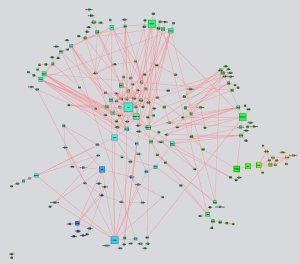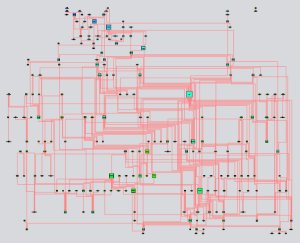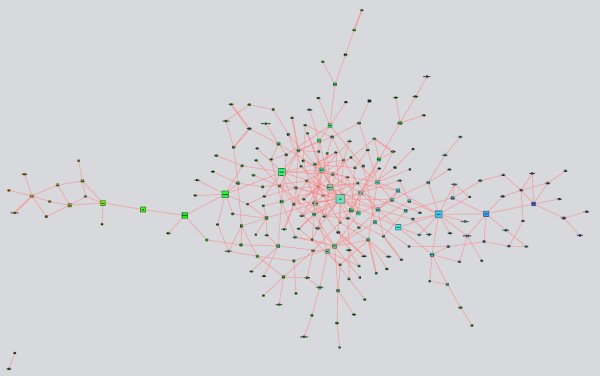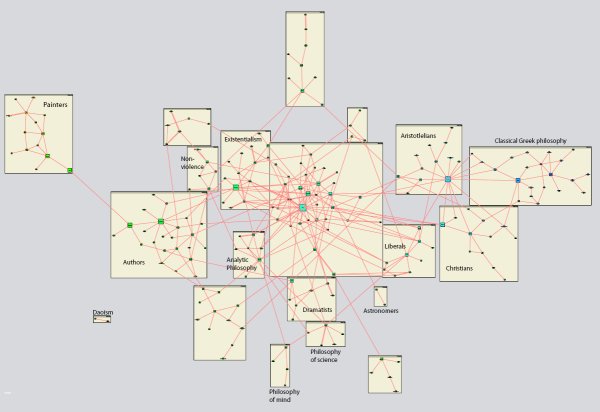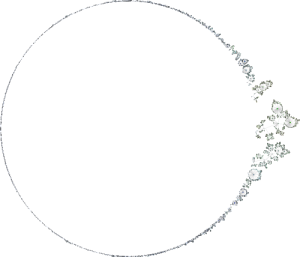October 09, 2006
Colorful Academic Genealogies
Mike Love's Genealogy of Influence is a fascinating resource tracing who has influenced whom in Western thought.
Of course, I couldn't stay away from the data so I pilfered it from the site and tried my hand at displaying it as static graphs using the excellent yEd. The results are in PDF, so they can be zoomed and searched.
I tried a hierarchical graph, organic (force-directed) layout and a circular layout. Each shows different things. The hierarchy makes the causality of influence stand out, but it is hard to see who belongs together with who. The circular layout is cute and produces some nice clusters, but their logic is hard to see. The organic layout gives a surprisingly good timeline and (as we shall see) reveals a lot of structure. I just wish I had remembered to reflect it so it goes left-to-right.
For color I used graph distance from Xenophanes. While Thales is earlier, his influence is somewhat backward in this dataset since it extends via Pythagoras and Aristotle, so it looks better with Xenophanes. There is a need to build up the pre-socratics; Wikipedia has a nice genealogy of the pre-socratics which ought to be included here.
Plotting size as betweenness centrality reveals an interesting thing: there really does seem to be a backbone of great thinkers in western philosophy. Plato, Aristotle, Aquinas, Kant, Nietzsche and so on stand out due to their size. Of course, there is always a risk of bias in selecting the genealogy (if I know much about philosopher X he is likely to get many links, increasing his importance).
The real gem was when I allowed yEd to find natural clusters. To my great surprise the clusters mostly make sense. There are obvious existentialist, christian, painter and author clusters, as well as clusters apparently corresponding to philosophy of mind and nonviolent resistance. My labelling is probably going to annoy experts, who are also likely to argue that Dante isn't an aristotelian and that Hesse should be in the author cluster, but I leave them to argue with yEd. While Love's data had explicit attributions of people into different groups this clustering is done just on the graph itself. I guess this shows that the genealogy he created makes sense - the structure fits the historical structure we tend to organise things into. Whether this is actually a true structure is another matter, of course.
If I were to extend this, I would of course add a lot more scientists and political thinkers. A more fun thing would be to take a philosophy encyclopedia, extract the entries denoting philosophers, and use occurences of other philosopher names in entries to create links. This kind of automated construction will no doubt be noisier and of lower quality, but could become far larger. The Philosopher Family Tree and the The Mathematics Genealogy Project (and the emerging theoretical and high-energy physics ones) could add a bit of information too. But unfortunately teacher-student links doesn't necessarily imply much influence.
A case in point would be my own genealogy: I can trace much influence to my advisor, but his advisor is in a somewhat different field (computer vision), and his advisor moved into the field from mathematics. My delight in differentiable objects is hardly inhereited from them. Still, it is pretty cool to see that I can claim both Felix Klein and David Hilbert as my (advisor)7! Going backward I find C.F. Gauss as (advisor)10 as well as all the greats of analysis up to Leibniz as (advisor)15. Of course, that is not surprising. Any genealogical tree will eventually end up with a few greats, especially when there are a few people with two advisors. And the Leibniz family is the biggest one in both philosophy and math.
Still, I couldn't resist plotting the entrie The Philosopher Family Tree:
Since it is a tree (I left out the root nodes) the circular layout works great, although the large number of small 'families' create the elegant ring-like shape. The big fractal to the right is the Leibniz cluster, in this case the philosophical descendants of Mr Monad rather than the mathematical ones (although many are represented). For some reason text searching doesn't work as it should in the document, which is unfortunate. I did a PDF of just the Leibniz cluster, and there it works.
It would be interesting to construct a Wikipedia interface along these lines, so that one could see the links and clusters in idea-space, in academia-space and family-space around a person.
Posted by Anders3 at October 9, 2006 04:20 AM